Managing Cross-platform Game Development while Separated
How would you manage a game development team when separated during a global pandemic? We’re still alive somehow, so we thought we’d share how we’ve managed to keep working with one another these past months.
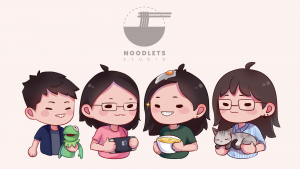
Hi, we’re Noodlets Studio. You might recognise us from the Chicken Time Tutorials we’ve been serving up. We hope they’ve been informative!
_________________________________________________________________________________________________________
The Game in Question
If you read our first article, you might remember that we’ve been working on another chicken-related game called ‘Yi’s Eatery’. It’s a chaotic couch co-op cookstravaganza across VR and mobile devices that puts you and your friends in charge of cooking, crying, and customer service! After all, who doesn’t love cryi- we mean, cooking.
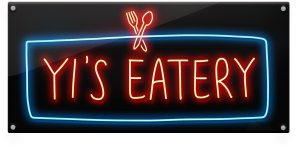
Collaboration Tools
The pandemic has made things… difficult. How do we pass files around? How do we keep track of who is doing what, and by when? How are we supposed to test whether multiplayer works when none of us have access to all the devices we need?
On top of that, this game we’re developing is only for one module. We have four other modules, all with their own assignments and tests. The past few weeks have been especially rough because we had a bunch of assignments and quizzes.
With the help of online tools like Discord, Jira and Google Drive, we’ve been able to manage. So far. The internet has been our saviour.
Passing Files Around

How Google Drive has helped us is pretty straightforward. We’ve made a team drive to store our gazillion assets, Unity files and documents. It takes a while to upload and download everything to the cloud, but Google’s cloud service has been invaluable.
Keeping in Touch

Because it’s easy to lose touch now, we’ve made it a point to have a meeting every morning to update one another on our progress. We’ve primarily been conversing through Discord because of its myriad of useful features, and also, we’re all #gamers.

For our Production Management module, we’ve been learning how to use the scrum methodology. To keep track of our progress and workload in the scrum format, we’ve been using the web tool Jira. We all normally just go with the flow when it comes to scheduling, so this was tricky to get into. However, it’d definitely be a lot harder to keep track of everything we have to do without it.
Testing Our Game
Aixian, our networking goddess, has found a workaround for testing her networking prototypes. She runs multiple builds of the game through emulators on her computer. It’s tedious, but it’s worked so far.
Meanwhile, on the Virtual Reality (VR) side of things, Kai Yuan and Krystal have been testing their mechanics out by donning the Oculus Quest. It’s all good there.
The real problem comes in when we have to meet up to actually test the game out by connecting the two platforms, but we’ll cross that bridge when we get there. Phase 2 has also started so it should be considerably easier to get together now.
Social Media
However, there’s more to game development than just the actual development. Marketing is half the battle when trying to share a game. That’s why one of our modules is on Social Media and Branding!
Here, our social media manager, Nicole, will be sharing her thoughts on building a community online through social media.
Amphibistudio Takeover
We had to take over Amphibistudio’s social media accounts for 2 weeks, read on to find out what happened behind the scenes!
Content Creation
As you may know, Chicken Time is a short 8-part tutorial series on how to make a simple Snake-esque game. It was a manifestation of our brainstorming and ideation when it was Noodlets’ turn to take over the Amphibistudio social media.
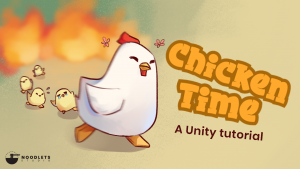
Amphibistudio has always been a group of people interested in game development, and its main goal is to get other people into game development through conducting workshops, game nights and sharing our creations.
In line with Amphibistudio’s goal, we wanted to make a game together with our audience (that’s you!). A game easy to follow along with, and easy to hop into at any point of the tutorials! We wanted to teach you, our audience, how to make your own mobile game during the short 2 weeks we had. When all is said and done, we just wanted all of you to take away something memorable after Noodlets is done taking over Amphibistudio.
And what better way to do that than through a game? Thus, Chicken Time was born.
Management
Managing the accounts was… harder than we expected. Simply because there were so many things going on at the time of our takeover. For starters, a few assignments were due on the very first week, so we had to juggle our time between doing up the content for the takeover and completing our assignments. The timetabling schedule of our posts was also packed to the brim, a new post was scheduled to go out every weekday.
In case you’d like to see what it looks like, here it is:

There were a few problems however. Making an easy-to-follow and accessible tutorial series meant that we had to go into detail of where to get assets, where to place assets in the scene, and what code to include in the scripts. This meant we had to include a lot of pictures, and this took up a surprisingly significant chunk of our time. This was on top of having to make the actual game at the same time, and we were not prepared for this.
It is no wonder that the game designer and programmer of Chicken Time found the workload too heavy. A game that was meant to take no more than 3 days to complete was taking us a long time because of all the pictures we had to include, and it didn’t help that there was a deadline we had to meet the coming Monday, not to mention the other assignments and a presentation to prepare for. This resulted in us having to make some minor adjustments to our posting schedule.
Don’t get us wrong, it did help us a little bit, and we got back on track the next week! However, it can’t be denied that making the tutorials, and writing the articles takes a lot of time and effort and can very often drain us at the end of the day.
Visuals
While we did use some borrowed visuals (3D assets from the Unity Asset Store), we whipped up a cute illustration for the title screen of Chicken Time, which has also been used as the header for the articles on the Amphibi website and turned into a downloadable wallpaper.
The posts on Instagram have used the same coloured outlines for consistency, along with bolded titles for the tutorial’s number and name. Where possible, we tried to provide videos as covers and as ending slides so that viewers can have a clearer understanding of the end goal of each tutorial.
Here are all the posts from our journey thus far, you can check it out here!
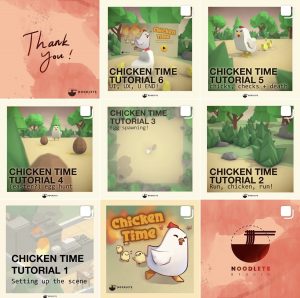 Noodlets Studio
Noodlets Studio
We also have our own social media accounts to handle, read on to find out what goes on behind the pretty posts!
Noodlets Studio Content Creation
Upon creating the Noodlets Studio social media accounts, the first and most important hurdle we had to overcome was the content to put out. What sort of content should we show, and how feasible is it? Knowing that we had to manage these accounts throughout our journey of making the game meant that we had to plan our time wisely and our content must be manageable to some extent.
The first few posts were easy enough, we just had to introduce our studio, ourselves, and finally, our game. What about the content after that, then?
To help with this, we did some research on other game developers’ social media to get a feel of what people in a similar industry would usually post. After doing enough research, we sort of had an idea of what to post. So we settled on showing snippets of our development process. We wanted to share our process with our audience (that’s you!) while also documenting down our own progress in our game, Yi’s Eatery.
Initially, we had planned to share concept art, 3D block-ins, mechanics and the likes. However, we thought adding in tutorials would be interesting too, so we tried to add tutorials wherever we could. We currently have 2 up on our account, you can check it out on our Instagram!
Management
We started planning for this early. We had an entire schedule planned out – posting three times a week, on scheduled days and times – but frankly, what with balancing work for other modules and actually working on developing the game, we had to make some adjustments to the plan after the first few weeks. After posting the concept art, we just had to take it slower because development content is much more time-consuming to create. We reduced the number of posts to two a week, though we’re so flexible we sometimes just go with one…or none. (Especially when it came to our AmphibiTakeover weeks!)
As it turns out, managing our studio account is still pretty manageable, despite our difficulty with deciding what content to post every week. We’re still adhering to our layout and it’s going alright so far. If you’d like, you can check out this link and give us a follow on our socials!
Visuals
At first, we’d planned a seamless three-column layout, but it fell through after we realised that it would create an uneven grid because we have four member chibis to post. After some discussion, we came up with our current layout:
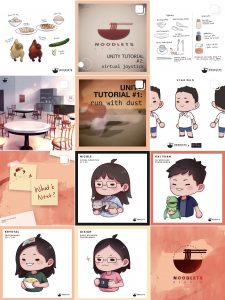
We’d have concept art and development posts on the side columns and tutorials in the middle column. We adopted our studio’s colour palette for post outlines and story highlights (yellow, light orange, coral, and dark grey) to keep the overall theme consistent and aesthetically appealing.
You can see it for yourself here!
Staying in Touch
It’s been a while since us Noodlets have seen each other in person. However, despite all of the inconveniences that COVID has brought about for our project, we have managed to get by and maintain a decent level of socialisation with each other. 2 months on, it almost seems like we have settled into this new lifestyle, but with the arrival of Phase 2’s relaxation of lockdown measures, it seems us Noodlets find ourselves having to adapt to a different way of life again.
Firstly, it is important for people to recognise that it is normal to feel affected by the COVID situation. For many of us, this is our first time experiencing such a drastic change in our lifestyles, and it can seem daunting, given we have not experienced this level of stress. At Noodlets, we prioritise the mental health of our team. We encourage each other to be transparent about how we are feeling because it is impossible for us to be at our best all the time, especially in this situation. By being transparent with each other and ourselves, we avoid burnouts more often and we just generally have a happier atmosphere while we work on the project. We are committing to creating a game in which others can feel joy. To that end, we, as the developers, must feel that same joy as well when creating the game.
We also regularly get together to play games together to not only socialise during these tough times, but also to inject much-needed “feel-good” dopamine into our systems. Some of our favourite games include Animal Crossing: New Horizons, Animal Jam and Club Penguin. Looking back at it now, we sure do love games with animals… We have created some fun memories playing these games, check out our antics!
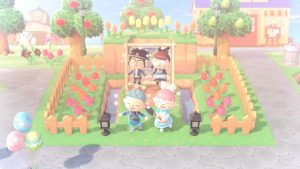
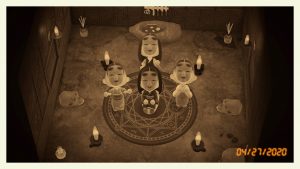


It is during these trying times, that we realise how important human connection is to us. However, this crisis has also shown us that even when we’re apart, there will always be a way for us to connect with each other. As a team, we must all look out for each other and to pick each other up when we inevitably fall. That’s how Noodlets Studio keeps on going despite being apart.

Thank you for joining us in our journey and do check out our socials for future updates on Yi’s Eatery, silly gifs and more game development!




